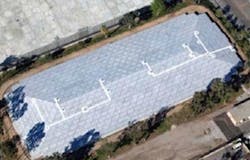Built in 1927 and upgraded in 1955, the Linden Reservoir of Riverside, Calif., had served well but was requiring more caretaking than in the past. John Farley, interim principal engineer at the Riverside Public Utilities Department compared the 61-million-L (16-million-gal) reservoir to an “elderly gentleman.” While it was serviceable and trustworthy, he explained, its roof needed a little more self-sufficiency, especially if it was expected to survive a major earthquake.
The Problem
As one of two major water-storage reservoirs forming the hub of Riverside’s water distribution system, the Linden Reservoir’s capacity was increased from 45,420 cu m (12 million gal) to 60,560 cu m (16 million gal) in 1955. At the time, a steel roof fashioned from corrugated metal cladding supported by concrete columns and a steel frame was added. Throughout the years, the roof has suffered from significant corrosion and other maintenance challenges.
In 1984, the reservoir underwent a major structural overhaul of its concrete lining, but the public utilities department had grown concerned about the age and condition of the reservoir’s roof—particularly the roof’s ability to withstand a major seismic event.
“On the whole, the old roof had performed well, but we started having more and more maintenance challenges, particularly with the cladding pulling away and extensive corrosion of the steel frame,” Farley said. “We had to continually inspect the roof and repair breaches to prevent contamination and keep foreign objects out.”
Ongoing maintenance costs for the roof became excessive. So the public utilities department explored replacement options and hired engineering firm URS Corp. of San Francisco to evaluate options based on four primary requirements:
- The roof needed to be long-lasting, durable and secure to keep out debris and other unwanted objects.
- The roof needed to be low-maintenance. Riverside was looking for a design featuring few components that would need adjustment, repair or replacement.
- The roof needed to sustain high seismic loads because of the region’s vulnerability to earthquakes.
- Construction had to be minimally intrusive and preserve the structural integrity of the existing reservoir—an approximately 61-m (200-ft)-by-52-m (500-ft) concrete-lined earthen-embankment structure.
“Since the Linden Reservoir is an old structure, we had to make sure alterations wouldn’t damage the existing reservoir floor,” said Miko Aivazian, the URS project manager. “We’ve seen enough of these situations over the years and have sufficient expertise and data on which to base our recommendations.”
The Solution
Aivazian and his team assessed 11 different roof design options, such as wood, welded steel, aluminum and even a floating membrane system. They recommended a low-profile prefabricated aluminum roof supported by stainless steel columns anchored to new pedestals in the reservoir floor. Canyon Springs Enterprises dba RSH Construction Services of Hemet, Calif., was awarded the project, and it subcontracted the roof design and manufacturing to CST Covers of Conroe, Texas.
CST’s aluminum covers are designed to conform to any shape of basin or underground storage tank, a versatility that makes them seismically resilient, which is an important quality given Riverside’s proximity to the San Andreas, San Jacinto and Elsinore faults.
“From an engineering standpoint, one of the advantages of the CST aluminum roof is its lightweight construction,” Aivazian said. “In the event of an earthquake, the roof must be able to expand and move independently from the rest of the structure. An aluminum roof introduces smaller seismic loads into the existing structure and walls.”
The roof installation included a complex but critical support system of concrete pedestals and four seismic walls along the perimeter.
“The roof is anchored to a wall, which runs around the perimeter of the reservoir,” said Matt Huckaby, URS project engineer. “We wanted to isolate seismic forces at four distinct locations around the reservoir so the roof supports wouldn’t have to absorb any seismic load. To achieve this, we had four [6-m] 20-ft sections of the perimeter wall removed and replaced those sections with a new anchoring system to transfer roof diaphragm seismic forces into the walls.”
When placing the 56 roof column supports, engineering and construction teams respected the existing reservoir structure. The existing columns supporting the old roof didn’t match the pattern required for the new aluminum roof, so crews cut the existing columns all the way to the base and preserved the existing pedestals, eliminating additional cuts to the floor slab.
The Results
The roof’s custom design and modular construction led to an efficient installation. Pieces were shipped, labeled and assembled at the job site. The lightweight materials required relatively little manpower and machinery to lift the pieces into place. Crews transformed the roof from an aging and corroded steel structure to a sleek, low-profile aluminum structure in just four months.
“The new aluminum roof, along with the structural modifications to the reservoir, will extend the life of the structure over 50 years,” said Hector Moreno, regional sales manager at the CST Covers.
The new roof cost little to install and will have easy long-term maintenance. Aluminum is not susceptible to damage from moisture, and it does not rust and does not have to be painted. The aluminum roof also is recyclable after its useful life. The low profile also enhances the reservoir’s aesthetic appeal, Farley said.
“Driving by, you can’t really tell it’s a reservoir,” Farley said. “What you see is basically a landscaped embankment rising up from street level, and the new roof is essentially disguised in the background.
“I credit the success of this project to the great teamwork between Riverside, the URS engineering team and the contractor and subcontractors.”
